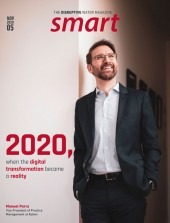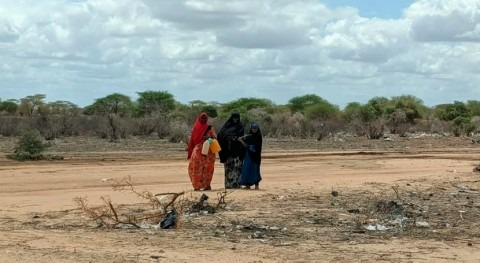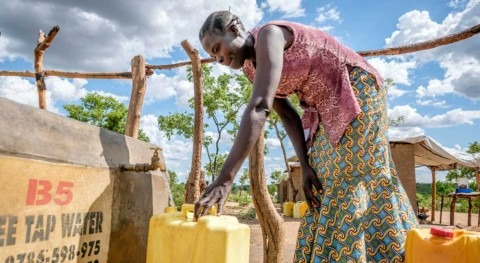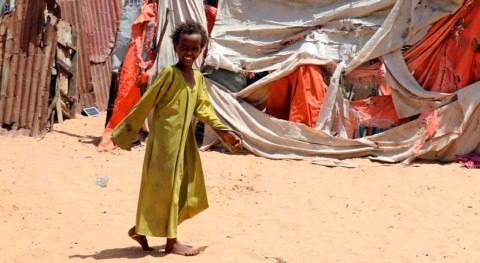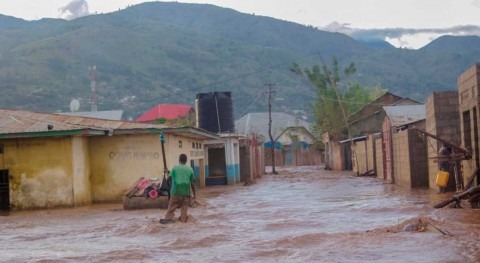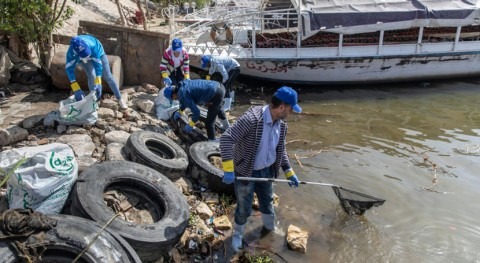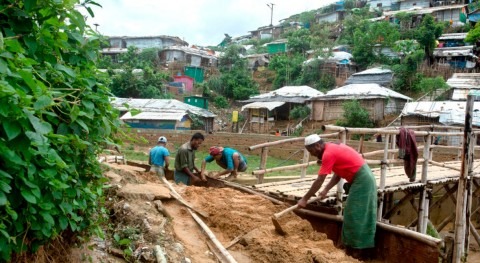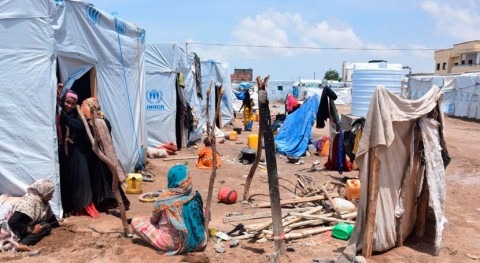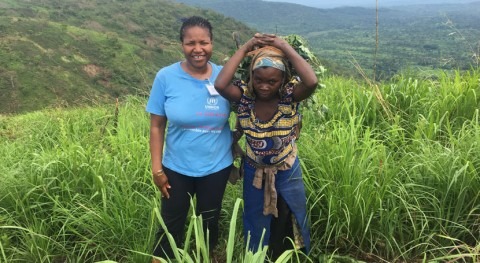The WASH response of the United Nations High Commissioner for Refugees (UNHCR) in emergency settings ensures immediate survival, dignity and the prevention of disease. While supplying safe drinking water to emergency settlements is a must, delivering water by truck is expensive and difficult to monitor. A UNHCR team of engineers in charge of WASH operations came up with a solution that has received a prestigious award from the European Innovation Council. We hear from Ben Harvey, lead engineer on this project, about the use of new technology to improve water service delivery and reduce shortages in refugee settlements.
Question: What does it mean for you and your team to win the European Innovation Council Horizon Prize on Affordable High-Tech for Humanitarian Aid?
Answer: This is a huge honour for UNHCR and we are delighted to have been chosen as the winners of the €1 million ($1.18 million) EIC Affordable High-Tech for Humanitarian Aid Prize for the Water, Sanitation and Hygiene category. We are extremely grateful to the European Innovation Council as it would be impossible for UNHCR to innovate with new technologies in humanitarian settings without their generous support.
The COVID-19 lockdowns have shown us that UNHCR needs solutions to monitor that refugees are receiving their rights to water
Q: Can you tell us how the project to develop and implement novel technology to monitor water delivery and consumption in refugee settlements came about?

Ben Harvey. Device range testing. Uganda
A: This technology mainly came out of response to the complex humanitarian situation in 2017/2018 where almost a million South Sudanese refugees crossed into northern Uganda. At this height of this crisis over 600 water trucks were providing water to half a million refugees. The reality is that UNHCR manages many large water supply operations for millions of refugees worldwide. In some rapid-onset complex emergencies, UNHCR can quickly find itself having to scale up to meet the needs of refugees. Monitoring emergency water provision in these difficult contexts can be very challenging. The recent COVID-19 lockdowns have also shown us that UNHCR needs solutions to monitor that refugees are receiving their rights to water during times of limited access.
Q: What does the technology consist of, and where has it been applied so far? Do you think it can be applied in other type of emergency scenarios?
A: UNHCR reviewed the IOT technology landscape (Sigfox, LoRaWAN, NB-IOT, LTE, 3G, 4G, Satellite) for real-time monitoring of water systems and identified LoRaWAN (Long Range Wide Area Network) Internet of Things (IOT) technologies, typically applied in Smart Cities, as a potential game-changer for humanitarian settings. Our pilots in Uganda and Northern Iraq showed us the technology was mature and we were amazed to see the LoRaWAN water sensors sending data to the Gateway over 25 km away. To date, we have installed ten (10) LoRaWAN Gateways in Refugee Camps and are currently installing four (4) Gateways to cover 1 million refugees in Cox’s Bazaar, Bangladesh in collaboration with our partners. In terms of sensors, we have installed LoRaWAN ultrasonic water level in water reservoirs, LoRaWAN flow meters, LoRaWAN borehole groundwater level sensors and are working with Veolia Foundation to install real-time chlorine and turbidity sensors. We also have a strong policy of solarization of water pumping and plan to install LoRaWAN pulse readers and LoRaWAN weather stations, equipped with solar irradiation sensors, to help us monitor efficiency.
UNHCR reviewed the technology landscape and identified LoRaWAN IOT technologies as a potential game changer for humanitarian settings
Q: To what extent are the solutions you have developed helping to deliver WASH services in these settlements and beyond?
A: These solutions are helping us ensure visibility and transparency that refugees are receiving their rights to adequate services of water and sanitation during times of limited access. This information is critical for UNHCR to fulfil its mandate and ensure accountability to our persons of concern. In addition, optimizing the delivery of water, results in cost savings, thereby increasing cost-effectiveness and maximizing the impact of humanitarian aid. By monitoring our water networks, we have been able to minimize water leakage, identify and adjust under-sized and over-sized elements of the system, and address irregularities in system operation.
UNHCR has found that Smart City Internet of Things technologies have the potential to radically change the way humanitarian organisations monitor refugee operations. UNHCR has found that many Smart Cities technologies are better suited to refugee settings than built-up urban environments. UNHCR’s piloting of this technology has impacts not just for real-time monitoring of Water Infrastructure but practically all humanitarian sectors (Health, Shelter, Energy and Environment). With many refugee settings still in lockdown with COVID-19, the importance of real-time remote-monitoring has never been greater.
Optimizing the delivery of water results in cost savings, increasing cost effectiveness and maximizing the impact of humanitarian aid
Q: The EIC Horizon Prize entails €1,000,000 in prize money. What are the plans so far to invest that amount?
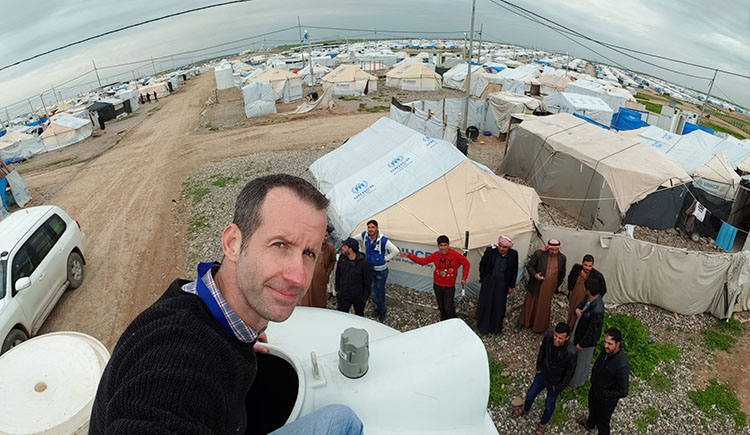
Ben Harvey. Salamiyah camp, Mosul. Iraq
A: Currently, we have a strategy to use the prize money that has four (4) components. The first is to support existing refugee operations (Uganda, Kenya, Bangladesh, Tanzania, Rwanda, Iraq) where we have already started real-time water monitoring. The second is to expand to new refugee operations. The third is to improve our information visualisation platforms, for example, to provide clear alerts when pumps have stopped, water reservoirs are empty, water quality levels fall below norms (we received funding from the Dutch Ministry of Foreign Affairs via Dutch Surge Support to create a free to use, open-source visualisation platform for humanitarian NGOs that leverages the open-source platform The Things Network). The final aspect is to do a better job of sharing our experience with the humanitarian water and sanitation community and produce clear guidance, lessons learned documents, video training and webinars. We are also hoping to expand beyond water monitoring and look at smart monitoring technologies for sanitation and faecal sludge operations.
Q: Can you tell us about further high-tech development initiatives within the UNHCR? What challenges are you hoping to address in the near future?
A: At the moment we are particularly interested in technologies that allow humanitarian actors to monitor efficiency, detect leaks, monitor water quality, monitor energy and protect the environment. Currently, we are very interested in developments around smart water dispensers (e.g. using RFID tags to dispense set quantities of water at public water points – with the aim of introducing cost recover). Smart water technology is advancing so much that we are continuously looking at what technology works well and can be applied to the humanitarian scope. We are also particularly interested in any solutions that can help our water systems reduce costs, become more efficient, become more accountable (to donors, partners and the refugees themselves) and become more environmentally friendly. We are also particularly interested in technologies that are simple, robust, low-cost and can be handed over to local government service providers at some stage down the line.
UNHCR has found that many Smart Cities technologies are better suited to refugee settings than built-up urban environments
Q: Do you think COVID-19 could accelerate the provision of water services in refugee camps?
A: Absolutely, regretfully we had three installation trips planned just when COVID-19 started that had to be postponed. If we had managed to get the remote monitoring equipment installed before the COVID-19 lockdowns we would have had a very clear picture of the water situation in various refugee camps before we lost physical access to the sites because of lock-down. We understand with the additional demand for increased water for handwashing that our limited services are being stretched. There has never been a more important time for real-time monitoring.





